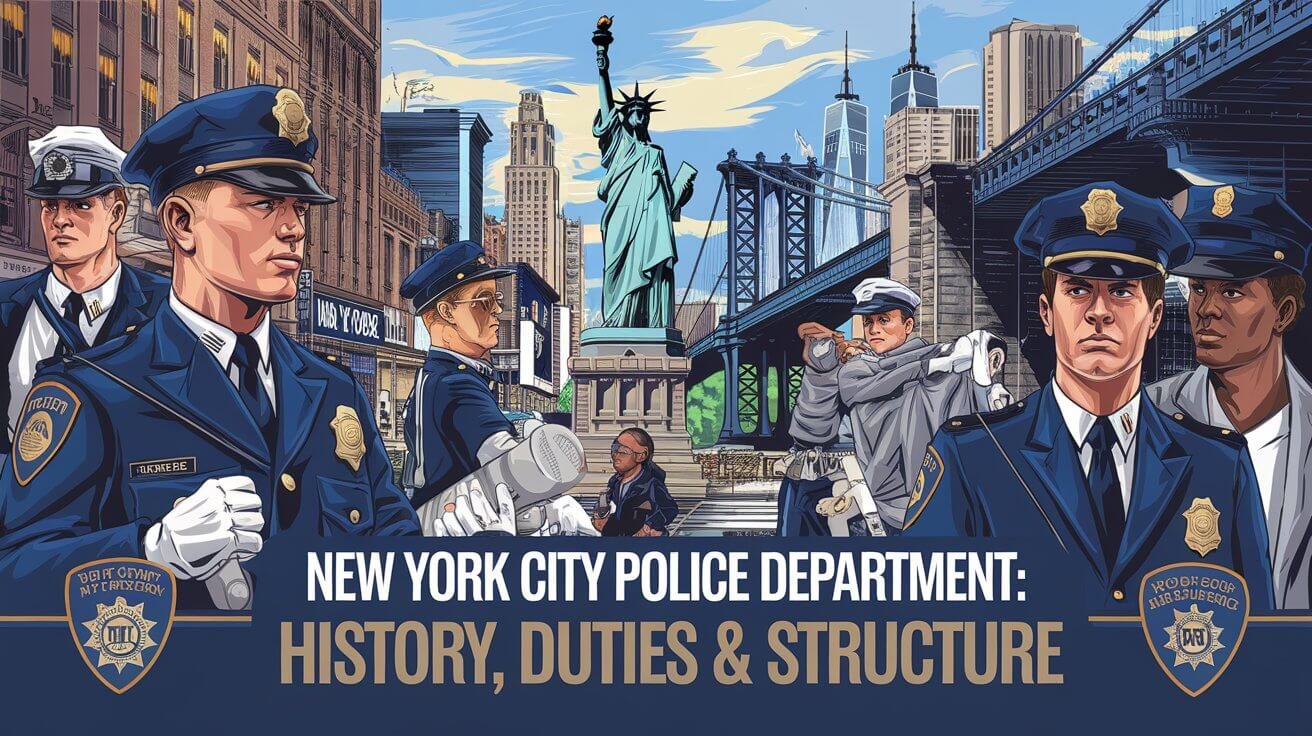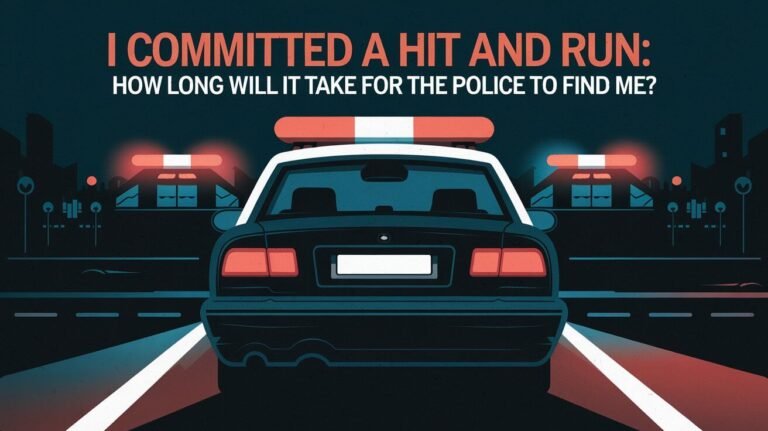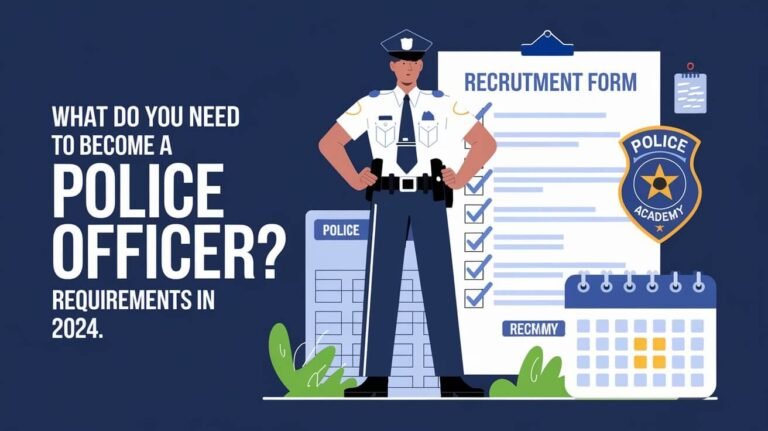New York City Police Department: History, Duties & Structure

The New York City Police Department, or NYPD, plays a key role in keeping the city safe. It has a long history of over 175 years. The NYPD is the largest and one of the oldest police departments in the U.S. It focuses on law enforcement and public safety.
With about 50,676 people working, the NYPD has a strong team. This includes around 33,000 sworn officers and 19,000 civilian employees. They work hard to protect and serve New York City’s people.
The NYPD covers a big area of about 468.484 square miles. It serves a population of around 8,468,190 people. In 2022, its budget was US$5.4 billion. This shows how important the NYPD is for public safety.
NYPD’s Historic Journey from 1845 to Present
New York City Police Department (NYPD) has a rich history spanning over 178 years. It started in 1845, marking the beginning of organized policing in New York City. The NYPD’s journey is filled with growth, evolution, and transformation. It has become a world-class law enforcement agency, leading in innovation and progress.
The NYPD’s history is filled with milestones. It includes the first police academy, advanced crime-fighting technologies, and community-based crime prevention strategies. The department has seen many reforms, reflecting changing societal views and demands for accountability. Today, the NYPD is one of the largest and most advanced police departments globally, with nearly 38,000 officers protecting New York City. Its commitment to crime prevention and evolution has made it a model for other police departments.
Birth of America’s Largest Police Force
The NYPD was founded in 1845, after the Municipal Police Act was passed in 1844. At that time, the city had about 320,000 people and 1,200 officers. The department has grown, with key events shaping its history, like the first police academy and advanced crime-fighting technologies. The NYPD’s history shows its dedication to law enforcement evolution and crime prevention.
Evolution Through Major City Events
The NYPD has played a role in many significant events, like the New York Draft Riots and the Tompkins Square Riot. The department has also seen major reforms, such as the Lexow Committee in 1894, which looked into corruption. These events have shaped the NYPD into what it is today, with a strong focus on crime prevention and evolution.
Transformation into Modern Policing
Today, the NYPD is a top law enforcement agency, dedicated to crime prevention and community-based policing. It uses advanced technologies, like fingerprinting and DNA analysis, to fight crime. The NYPD’s modern transformation shows its commitment to evolution and prevention, making it a model for other departments.
| Year | Event | Description |
|---|---|---|
| 1845 | Establishment of the NYPD | The NYPD was established, marking the beginning of organized policing in New York City. |
| 1894 | Lexow Committee | The Lexow Committee was established to investigate corruption within the NYPD. |
| 1901 | First Police Commissioner | Michael Cotter Murphy was appointed as the first police commissioner of the NYPD. |
Organizational Structure of Today’s NYPD
The NYPD is a complex law enforcement system. It has several bureaus working together to serve New York City. The police commissioner leads the department, making important decisions.
The NYPD’s structure ensures a clear chain of command. Each bureau has its own duties. For instance, the Patrol Services Bureau handles uniformed patrols. The Special Operations Bureau manages big events and incidents.
- A clear chain of command, with each bureau reporting to the police commissioner
- A division of labor, with each bureau responsible for specific functions and services
- A system of accountability, with each bureau and precinct held responsible for its performance and outcomes
NYPD is divided into precincts, each covering a specific area. This setup helps the NYPD serve New York City well. It also allows for quick responses to emergencies.
Police Precincts Across Five Boroughs
The New York City Police Department has 78 police precincts. Each one covers a specific area. These precincts are key to the department’s community policing efforts. They provide law enforcement services and build trust with the communities they serve.
Police stations are at the center of community policing. They are where the NYPD engages with the community. The department has created new programs to strengthen these relationships. This helps make New York City safer for everyone.
Precincts by Borough
The 78 precincts are spread across the five boroughs. Each borough has its own challenges. The precincts are managed by captains, deputy inspectors, or inspectors, depending on their size.
- Manhattan: 21 precincts
- Brooklyn: 23 precincts
- Queens: 18 precincts
- Bronx: 12 precincts
- Staten Island: 4 precincts
The NYPD’s precincts are vital for public safety. They offer dedicated law enforcement services and engage with local communities. This makes New York City safer and more vibrant.
Specialized Units and Task Forces
The New York City Police Department (NYPD) has many specialized units and task forces. Each one is made to handle different challenges. They are filled with skilled police officers and the newest technology.
Some key units are the Emergency Service Unit, the Aviation Unit, and the Counterterrorism Unit. These teams are vital in emergencies, solving complex crimes, and keeping the city safe. The NYPD’s task forces, like those against organized crime and narcotics, work hard to stop criminal groups.
The NYPD’s specialized units and task forces are key to its law enforcement success. They help tackle a wide range of crimes and safety issues. This includes terrorism, cybercrime, gang violence, and more. The NYPD’s focus on these areas makes it a leader in policing worldwide.
- Emergency Service Unit: provides emergency response and tactical support
- Aviation Unit: provides aerial support and surveillance
- Counterterrorism Unit: investigates and disrupts terrorist activities
The NYPD’s units and task forces use the latest tech and training. They also work with other groups to stay ahead of threats. As the biggest police force in North America, the NYPD aims to protect its citizens. Its specialized teams are a big part of this mission.
Training Academy and Professional Development
The New York City Police Department (NYPD) has top-notch training programs. These ensure police officers are ready for their jobs. They learn about firearms, first aid, and law enforcement from the start.
The NYPD’s police academy is in College Point, Queens. It’s a modern facility, thanks to a big investment. This place is designed to give officers the best training.
The NYPD’s training includes:
- Recruit training: a program that teaches the basics of law enforcement
- Advanced officer education: training for officers who want to move up
- Leadership development initiatives: programs to help officers become leaders
These programs help officers do well in their careers. They make sure the NYPD can handle today’s policing challenges. The NYPD really cares about its officers’ growth and success.
| Training Program | Description |
|---|---|
| Pre-Employment Police Basic Training Course | A program that includes training before and after joining the force |
| Basic Course for Police Officers | A required course for anyone wanting to be a police officer |
Technology and Crime Prevention Systems
New York City Police Department (NYPD) leads in law enforcement innovation. They use various technologies and systems to protect the city. The NYPD’s tech includes the CompStat 2.0 system, which offers real-time crime data and analysis.
This helps the department spot trends and patterns. They can then create strategies to tackle specific crimes.
Some key technologies used by the NYPD are:
- ShotSpotter, a system that finds gunfire incidents in real-time, even without 911 calls
- Domain Awareness System (DAS), a network of cameras and sensors for real-time surveillance
- Automatic Vehicle Locator GPS system, which improves patrol management and officer safety
The NYPD also uses mobile apps for real-time 911 data, wanted posters, and alerts. They are replacing their radio system with a new one soon.
| Technology | Description |
|---|---|
| CompStat 2.0 | Real-time crime data and analysis |
| ShotSpotter | Real-time locations of gunfire incidents |
| Domain Awareness System (DAS) | Network of cameras and sensors for real-time surveillance |
The NYPD’s tech and crime prevention systems are vital for keeping the city safe. They help the department respond better to crime and prevent it from happening.
Community Outreach Programs
The New York City Police Department (NYPD) is dedicated to reaching out to the community. They know how important it is to build trust and work together. The NYPD has many programs to help prevent crime and meet community needs.
One big part of their work is the NYPD community outreach. This includes many activities to connect with the public and offer support. It’s all about building strong relationships and helping each other out.
The NYPD also focuses on helping young people through their youth programs. They provide guidance and support to help kids succeed. This way, the NYPD hopes to stop crime, encourage learning, and grow future leaders.
Another key strategy is neighborhood policing. It brings police and community members together. This helps solve local problems and makes everyone safer.
Key Initiatives
- Community Partnership Initiatives: The NYPD works with local groups, businesses, and people to solve crime problems and improve life quality.
- Neighborhood Policing: This strategy helps police and community members build trust and work together to solve problems.
- Youth Strategies: The NYPD’s Youth Strategies Division finds “at-risk” youth and helps them avoid crime and grow positively.
The NYPD’s community outreach shows a big effort to make communities safer and stronger. With programs for youth and neighborhood policing, they aim to create a better place for everyone in New York.
Emergency Response Protocols
The New York City Police Department (NYPD) has emergency plans ready for quick action in big incidents and disasters. They team up with the FDNY and EMS to work together and help those in need. This teamwork is key to a good disaster response.
The NYPD’s emergency plans cover managing big incidents, coordinating disaster responses, and working with other agencies. For example, on September 11, 2001, the NYPD was vital in responding and working with others to get people out of danger zones. Their goals in disaster response include rescue, transportation, site security, investigation, and citywide security.
Key Components of Emergency Response
- Major incident management: The NYPD has plans for handling big incidents, like terrorist attacks and natural disasters.
- Disaster response coordination: The department works with other agencies to coordinate and support in emergencies.
- Inter-agency cooperation: The NYPD teams up with the FDNY and EMS for a successful disaster response.
The NYPD’s emergency plans aim for a quick and effective response to emergencies. Their disaster response goals are to keep the public safe and lessen disaster impacts. By working with other agencies and having good plans, the NYPD is ready to handle emergencies and keep the city safe. The NYPD’s emergency response, including NYPD emergency response, disaster response, and teamwork, is vital for the city’s safety.
| Agency | Role in Emergency Response |
|---|---|
| NYPD | Major incident management, disaster response coordination, and inter-agency cooperation |
| FDNY | Firefighting and emergency medical services |
| EMS | Emergency medical services |
Crime Statistics and Public Safety Impact
The New York City Police Department (NYPD) tracks crime to find trends and patterns. They use this info to prevent and respond to crime. This work helps keep communities safe by tackling specific crime problems.
Some trends show good news. For example, gun violence in New York State is at its lowest in years. The NYPD also saw a 2% drop in crime complaints by October 13, 2024. These numbers show the NYPD’s strategies are working well.
The following table highlights some key NYPD crime statistics:
| Crime Category | 2023 | 2024 | Change |
|---|---|---|---|
| Shooting Incidents | 791 | 723 | -9% |
| Crime Complaints | 100% | 98% | -2% |
| Major Felony Crime | 100% | 98% | -2% |
These stats show the NYPD’s dedication to keeping people safe. They prove the value of using data to fight crime and boost public safety.
Modern Challenges and Innovation
The New York City Police Department (NYPD) leads in tackling modern policing challenges. They use technology and new strategies to keep the public safe. In today’s digital world, they use social media to connect with the community and share news.
They have over 750,000 followers on Twitter across 111 accounts. This shows their dedication to policing in the digital age.
Some key initiatives by the NYPD include:
- Investing $140 million in mobile devices, including smartphones and tablets, to enhance officer efficiency and response times
- Implementing body-worn cameras to increase transparency and accountability
- Developing a redundant citywide fiber optic network to support advanced technology and data-driven policing
These steps show the NYPD’s commitment to innovation and connecting with the community. They tackle challenges like new crimes and how people see the police. By using digital policing and social media, they improve safety for New York’s 8 million people.
Digital Policing Strategies
The NYPD’s digital strategies help share information quickly. They work better with officers and the public. This way, they can tackle new crime trends and safety issues faster.
Community Engagement
Community engagement is key for the NYPD’s modern policing. Officers are encouraged to talk to people and build trust. The Neighborhood Coordination Officer (NCO) program is a big part of this, now in over 50% of precincts and Housing commands.
Conclusion
The New York City Police Department (NYPD) is dedicated to keeping everyone safe. It also works hard to be honest and open. The NYPD has a long history, with both great successes and mistakes.
This shows the need for the NYPD to always look at itself and work to get better. It’s a big job, but it’s essential for the community’s trust.
The NYPD has made big steps forward, like improving how it works with the community. But, it’s also had to deal with the costs of past mistakes. In the last five years, it paid out over $400 million in lawsuits.
In 2019, the cost was $68.7 million. These numbers remind us that rebuilding trust takes time and effort.
The NYPD must keep working to be open, train well, and serve the community. By using new technology, talking openly, and following strict rules, it can improve. This way, the NYPD can be a top example of law enforcement and keep New York safe for everyone.






